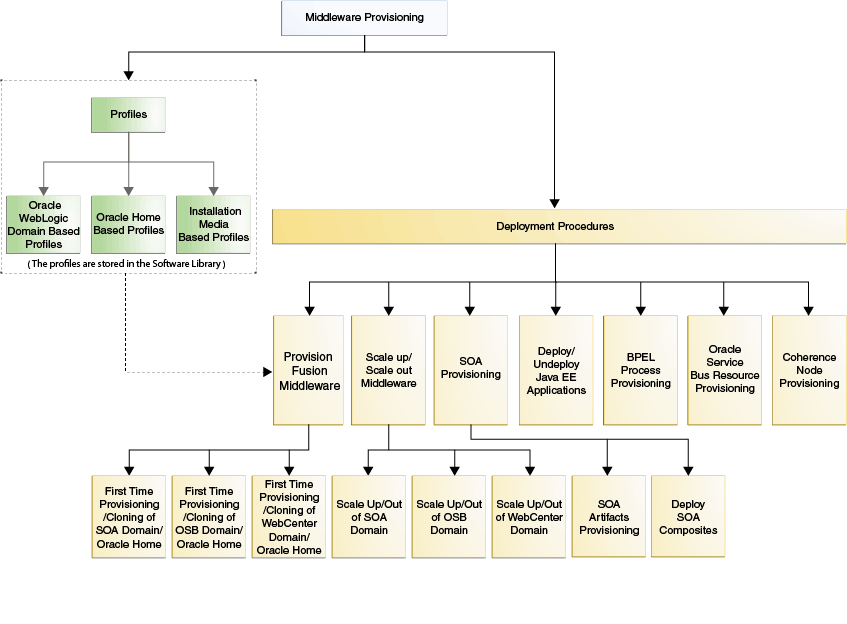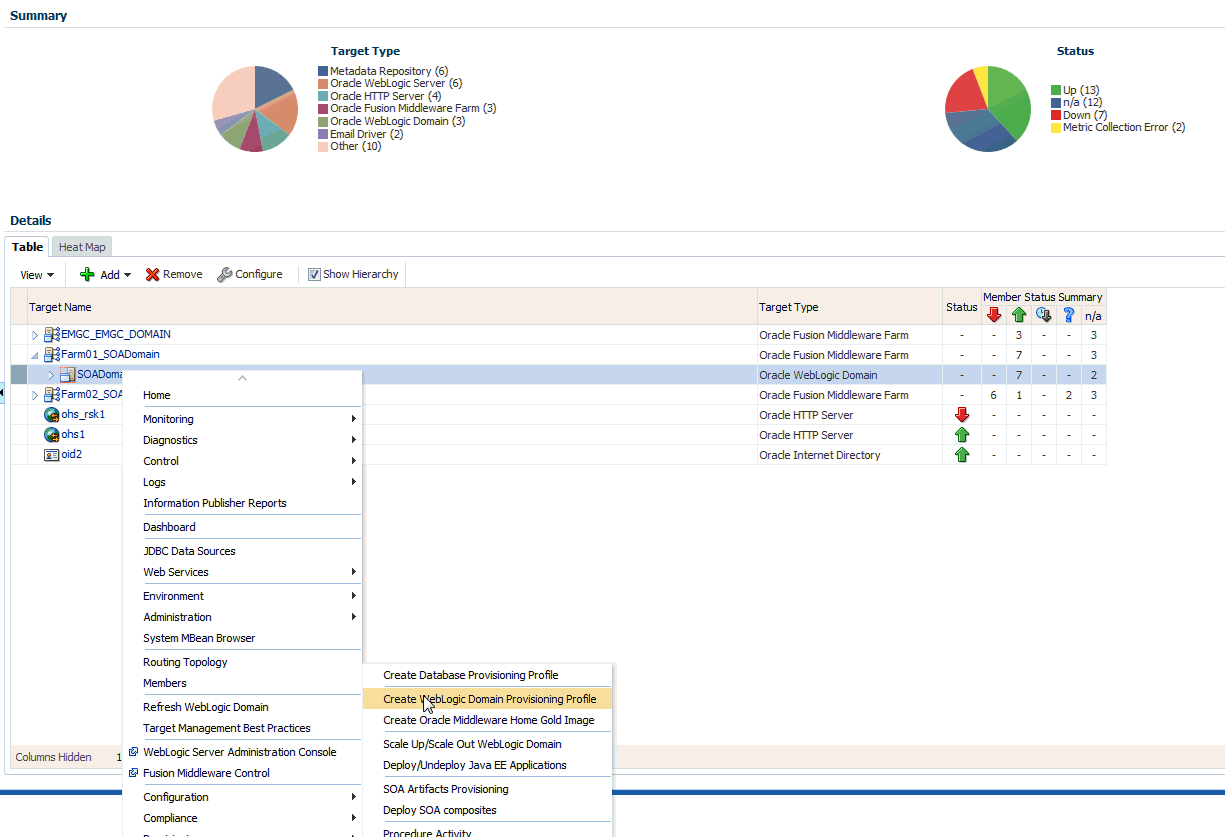22 Overview of Middleware Provisioning
Provisioning involves repeatable, reliable, automated, unattended, and scheduled mass-deployment of software, applications, or servers across different platforms, environments, and locations.
Middleware Provisioning involves remotely installing Oracle homes and configuration domains using automated deployment procedures. A deployment procedure is a pre-defined sequence of steps that is meant to perform a set of operations on one or more hosts monitored by Cloud Control.
In particular, this chapter covers the following:
22.1 Introduction to Middleware Provisioning
Provisioning is an important solution offered as a part of Lifecycle Management that enables you to provision middleware artifacts like WebLogic Domain, Java EE Applications, Coherence Nodes and Clusters, SOA Artifacts and Composites, Service Bus Resources, and Oracle WebCenter.
The following figure shows the Middleware Provisioning solutions offered in Cloud Control:

To manage these Deployment Procedures and Profiles effectively in Cloud Control there is a centralised middleware provisioning page which exposes all the features relevant to Middleware Provisioning like creating, viewing, and provisioning profiles and deployment procedures. To access this page, from Enterprise menu, select Provisioning and Patching, then click Middleware Provisioning.
You can launch the profiles page from the target home page. To do so, from Targets menu, select Middleware. Select a target of type domain, for example SOA Domain. From the WebLogic Domain menu, select Provisioning, and the options in this menu allow you to create a provisioning profile based on WebLogic Domain or Oracle Home.

The Middleware Provisioning page is categorized into the following sections:
The profiles section lists all the provisioning profiles that you have created and the profiles on which you have been granted access. You can:
-
Click the profile to view the profile details.
-
Filter the profile based on what you want to display in the Profiles table. To do so, from View menu, select Show Profiles, then click the option that you want to display. For example, if you click All, then all the profiles are displayed.
-
To clone a WebLogic Domain or an Oracle Home, select a profile and click Provision.
-
To create a new profile, select an option from the Create menu.
-
To delete an existing profile, select the profile name, and click Delete.
The deployment procedures section lists all the Oracle-provided deployment procedures, the Custom Deployment Procedures (CDP) that you have created, and the procedures on which you (the administrator you have logged in as) have been granted access. Select a deployment procedure from the list, and perform any of the following action on it:
-
To run a deployment procedure, select the procedure, and click Launch.
-
To create a copy of an Oracle-supplied deployment procedure, click Create Like.
-
To delete a User-owned deployment procedure, select the procedure, and click Delete. Note that, you can not delete Oracle-provided procedures.
-
To edit a deployment procedure, select the procedure and click Edit.
Note: You can not edit Oracle-supplied procedures. If you want to edit a procedure, you must first clone an Oracle-supplied procedure using the Create Like option. You can now edit the newly cloned procedure that you own. To do so, click Edit.
-
To grant other administrators, for example: EM_PROVISIONING_OPERATOR role, access on a particular deployment procedure, click Edit Permissions.
22.2 Oracle Fusion Middleware Provisioning Terminology
The definitions of terms listed in this section are useful in helping to understand the Middleware concepts presented in this part:
-
WebLogic Domain: A WebLogic Domain is a logically related group of Java components. A domain includes a special WebLogic Server instance called the Administration Server, which is the central point from which you configure and manage all resources in the domain. Usually, you configure a domain to include additional WebLogic Server instances called Managed Servers. You deploy Java components, such as Web applications, EJBs, and Web services, and other resources, to the Managed Servers and use the Administration Server for configuration and management purposes only.
-
Administration Server: The Administration Server operates as the central control entity for the configuration of the entire domain. It maintains the domain's configuration documents and distributes changes in the configuration documents to managed servers. The Administration Server is the central location from where you can monitor all the resources in a domain. Each WebLogic Server domain must have one server instance that acts as the Administration Server.
-
Managed Server: Managed servers host business applications, application components, Web services, and their associated resources. To optimize performance, managed servers maintain a read-only copy of the domain's configuration and security document. When a managed server starts up, it connects to the domain's Administration Server to synchronize its configuration document with the document that the Administration Server maintains.
-
Node Manager: Node Manager is a Java utility that runs as a separate process from Oracle WebLogic Server and allows you to perform common operations for a Managed Server, regardless of its location with respect to its Administration Server. While use of Node Manager is optional, it provides valuable benefits if your Oracle WebLogic Server environment hosts applications with high-availability requirements.
If you run Node Manager on a computer that hosts Managed Servers, you can start and stop the Managed Servers remotely using the Administration Console, Fusion Middleware Control, or the command line. Node Manager can also automatically restart a Managed Server after an unexpected failure.
-
WebLogic Server Home: A WebLogic Server home contains installed files necessary to host a WebLogic Server. The WebLogic Server home directory is a peer of Oracle home directories and resides within the directory structure of the Middleware home.
-
Middleware Home: A Middleware home is a container for the Oracle WebLogic Server home, and, optionally, one Oracle Common home and one or more Oracle homes. A Middleware home can reside on a local file system or on a remote shared disk that is accessible through NFS.
-
Oracle Home: An Oracle home contains installed files necessary to host a specific product. For example, the SOA Oracle home contains a directory that contains binary and library files for Oracle SOA Suite. An Oracle home resides within the directory structure of the Middleware home.
-
Cloning: The process of creating a copy of the WebLogic Domain and the Oracle home binaries present within the domain is referred to as cloning. Typically, cloning is performed at the WebLogic Domain-level. Fusion Middleware Domain cloning can be performed from an existing target or using provisioning profiles.
-
Provisioning Profiles: A profile is a snapshot of a live WebLogic Domain or Oracle Home, or it can simply contain a set of installation media archives pertaining to the product suite. A profile can be created from the Cloud Control or using Enterprise Manager Command Line Interface or through REST APIs.
-
Gold Image: The gold image is a single image that includes the binary and library files for an Oracle home.
For Oracle Fusion Middleware 11g, the Middleware Home was the top-level directory that comprised of multiple product-specific Oracle Homes. For example:
[user1@slc01avn middhome]$ ls Oracle_OSB1 Oracle_SOA1 coherence_3.7 domain-registry.xml logs modules oracle_common osb patch_ocp371 patch_wls1036 registry.dat registry.xml utils wlserver_10.3
For Oracle Fusion Middleware 12c, there is no concept of Middleware Home. Infact, the Middleware Home itself functions as the Oracle Home, and middleware products like SOA, Service Bus, WebCenter are installed within this folder directly. For example:
[user1@slc01avn OH12JRF]$ ls OPatch cfgtoollogs crs em install jdeveloper ldap mft nls oep oraInst.loc oracore oui plsql rdbms root.sh.old root.sh.old.2 soa srvm wlserver bin coherence css has inventory jlib lib network odi ohs oracle_common osb perl precomp root.sh root.sh.old.1 slax sqlplus webgate xdk
-
Scaling Up: When a managed server is added or cloned to a host that already exists in the domain or cluster.
-
Scaling Out: When a managed server is added or cloned to a host that is not present in the domain or cluster.
22.3 Supported Use Cases for Middleware Provisioning Procedures
This section lists all the supported use cases in the middleware space and the corresponding targets that get provisioned.
In particular, this section covers the following:
22.3.1 Provisioning Middleware Domains and Oracle Homes
This table covers the use cases for deploying SOA domain, Service Bus domain, WebLogic domain, WebCenter domain and Oracle homes.
Table 22-1 Provisioning Middleware Domains and Oracle Homes
| Deployment Procedure | Use Case | Targets Provisioned | Link |
|---|---|---|---|
|
Provision Fusion Middleware |
|
WLS 12.1.x, 10.3.x. |
|
|
Provision Fusion Middleware |
|
SOA Domain 11g |
|
|
Provision Fusion Middleware |
|
Service Bus Domain 11g |
|
|
Provision Fusion Middleware |
|
Oracle WebCenter Portal - 11g Oracle WebCenter Content - 11g |
|
|
Provision Fusion Middleware |
JRF WebLogic Domain Profile |
WLS 12.1.x, 10.3.x. |
22.3.2 Scaling WebLogic Server, SOA, Service Bus, and WebCenter Domains
This table covers the use cases for scaling an existing SOA Domain, Service Bus Domain, and WebLogic Domain:
Table 22-2 Scaling SOA, Service Bus, WLS, and WebCenter Domains
| Deployment Procedure | Use Case | Targets Provisioned | Link |
|---|---|---|---|
|
Scaling WLS Domain |
WLS 12.1.x, 10.3.x. |
||
|
Scaling up/Scale out Middleware |
Scaling SOA Domain |
SOA Domain 11g |
|
|
Scaling Service Bus Domain |
Service Bus Domain 11g |
||
|
Scaling WebCenter Domain |
Oracle WebCenter Portal - 11g Oracle WebCenter Content - 11g |
22.3.3 Deploying / Redeploying / Undeploying Java EE Applications
This table covers the use cases for deploying, undeploying, and redeploying Java EE Application.
Table 22-3 Deploying, Undeploying, or Redeploying Java EE Applications
| Deployment Procedure | Use Case | Targets Provisioned | Link |
|---|---|---|---|
|
Deploy/Undeploy Java EE Applications |
Deploying a Java EE Application |
Deploy Java EE Applications to and from WebLogic versions 10.3.1 and later, including 12.1.1, and 12.1.2. |
|
|
Undeploying a Java EE Application |
Undeploy Java EE Applications to and from WebLogic versions 10.3.1 and later, including 12.1.1, and 12.1.2. |
||
|
Redeploying a Java EE Application |
Redeploy Java EE Applications to and from WebLogic versions 10.3.1 and later, including 12.1.1, and 12.1.2. |
22.3.4 Provisioning Coherence Nodes and Clusters
This table covers the use case to successfully deploy a Coherence node.
22.3.5 Provisioning SOA Artifacts
This table covers the use case to successfully deploy the various SOA artifacts:
Table 22-5 Provisioning SOA Artifacts
| Deployment Procedure | Use Case | Targets Provisioned | Link |
|---|---|---|---|
|
SOA Artifacts Provisioning |
Provisioning SOA Artifacts from a Reference Installation |
Oracle SOA Suite 11gR1 (11.1.1.2.0 to 11.1.1.7.0):
|
|
|
Provisioning SOA Artifacts from a Gold Image |
Oracle SOA Suite 11gR1 (11.1.1.2.0 to 11.1.1.7.0):
|
||
|
Deploy SOA Composites |
Provisioning SOA Composites |
Oracle SOA Suite 11gR1 (11.1.1.2.0 to 11.1.1.7.0) SOA Composites |
22.3.6 Provisioning Service Bus Resources
This table covers the use case to successfully deploy Service Bus resources:
Table 22-6 Provisioning Service Bus Resources
| Deployment Procedure | Use Case | Targets Provisioned | Link |
|---|---|---|---|
|
Service Bus Resource Provisioning |
Provision Service Bus resources from Service Bus Domain |
Service Bus 2.6.0 - 2.6.1, 3.0.0, 10.3.0.0 - 10.3.1.0, 11.1.1.3.0 - 11.1.1.7.0, 12.1.3.0.0 |
|
|
Provision Service Bus resources from Software Library |
Service Bus 2.6.0 - 2.6.1, 3.0.0, 10.3.0.0 - 10.3.1.0, 11.1.1.3.0 - 11.1.1.7.0, 12.1.3.0.0 |